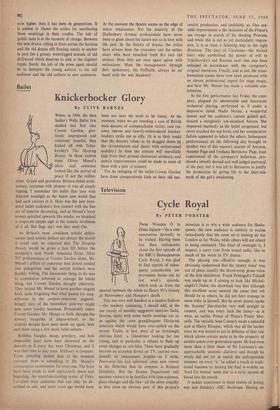Ballet
Knickerbocker Glory
By CLIVE BARNES As Britain's most consistent artistic dollar- earner (and artistic dollars are always the nicest) it could only be expected that The Sleeping Beauty would be given a face lift before the company's next North American foray. After 337 performances at Covent Garden alone, Mr. Messel's pillars of yesteryear had almost eroded into stalagmites, and the ostrich feathers were frankly wilting. The reasonable thing to do was to commission someone to redesign the whole thing, but Covent Garden thought otherwise. They invited Mr. Messel to have another elegant bash, quite forgetting that what passed for mag- nificence in the coupon-conscious, pageant- hungry days of the immediate post-war might now seem tawdry bombast. Presumably either Covent Garden, Mr. Messel or both, thought the scenery incapable of improvement, so the original designs have been made up again, here and there using a few more lurid colours.
Bobbles, bangles, beads, jewellery, and hats (especially hats) have been showered on the dancers as if every day were Christmas, and it was their turn to play trees. Millinery is rampant. From sweeping picture hats to the teensiest coronets there is something in Mr. Messel's cornucopian tastelessness for everyone. The boys have been made to look particularly sweet and beguiling. An uncertain-looking sextet of Fairy Cavaliers wear costumes that can only be de- scribed as odd, and some years ago would have been too near the truth to be funny. At the moment, when we are breeding a race of British male dancers of unimpeachable virility. cute cut- away sleeves and heavily-embroidered knicker- bockers strike me as silly. (It is to their credit that the dancers refuse to be dragged down by the circumstances and dance with embarrassed stolidity.) In time the colours will mercifully fade from their present clamorous stridency, and certain improvements could be made to most of them with a pair of scissors.
For its restaging of the ballet Covent Garden have done comparatively little to their old suc- cessful production, and justifiably so. One sen- sible improvement is the inclusion of the Prince's sea voyage in search of his sleeping Princess, and while this is not as yet particularly impres- sive, it is at least a faltering step in the right direction. The part of Carabosse—the wicked fairy who symbolised the power of evil to Tchaikovsky's sad Russian soul—has also been enlarged in accordance with the composer's original intentions. Finally, and at last, the trans- formation scenes have now been produced with an almost professional regard for stage magic, and here Mr. Messel has made a valuable con- tribution.
At the first performance last Friday the com- pany, plagued by abominable and inaccurate orchestral playing, performed as if under a depressive cloud. Nadia Nerina, a wonderful dancer and the audience's current golden girl, danced a marginally sub-standard Aurora. She improved markedly as the ballet progressed, but never touched her top form, and her comparative failure appeared to infect the others. Subsequent performances on the following day brought in another two of this season's quartet of Auroras, Annette Page and Svetlana Beriosova. Page, least experienced of the company's ballerinas, pro- duced a sweetly danced and well-judged portrayal of the part, but it was left to Beriosova to justify the production by giving life to the fairy-tale myth of the girl's awakening.










































 Previous page
Previous page